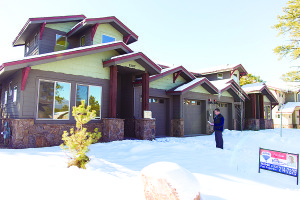 Welcome to “At Home with Tom and Sandy!” This month, we have a hot topic. As Tom and I always say, we are here to give you the inside scoop on real estate, the construction industry; what’s up, what’s down; what’s hot, and what’s not. We’ll share real estate stats, home prices, building permit numbers, construction pointers and give you hints on renovations that will give you a return on your investment.
Welcome to “At Home with Tom and Sandy!” This month, we have a hot topic. As Tom and I always say, we are here to give you the inside scoop on real estate, the construction industry; what’s up, what’s down; what’s hot, and what’s not. We’ll share real estate stats, home prices, building permit numbers, construction pointers and give you hints on renovations that will give you a return on your investment.
There is plenty going on in the housing and construction industry and we want to share some interesting information with you this month. So, settle in and enjoy.
Sandy: Okay, Tom, what is our sizzling emotional topic this month?
Tom: Multi-gen housing.
Sandy: Tom, I am pretty sure you are not talking about multi generators and back-up battery packs as energy sources for coffee pots, ovens, dishwashers and rowing machines are you? Multi-gen?
Tom: Ha, Sandy! All in the Family Multigenerational Living is making a comeback – multi-gen housing for short – where two and three generations are living under the same roof.
Sandy: Tom, I am seeing more and more folks visit my office – adult children and parents or a parent with them. So, one is to assume that more generations are sharing a roof as a growing number of adult children move back in with their parents and aging parents move in with their grown children. WOW, I can think of a bazillion reasons why that would be a challenge, but I get it. What are you seeing age-wise with families?
Tom: I am seeing and designing home features that accommodate younger generations, 20- and 30-year-olds moving in with their parents and I am also beginning to see the 40-year-old generation with their children moving back in with parents.
Sandy: How do you wrap your arms around a design concept to accommodate generations, personalities and different life styles all under one roof? There are a lot of considerations.
Tom: Now you know I am thinking like an architect and builder here. We have remodeled homes for what has been call a “Mother in Law quarters.” Multi-gen is not a “Mother in Law suite.” We are starting to see new homes being built and remodeled with two master suites and one small and one larger kitchen.
Sandy: I know we are not talking about a duplex here, but explain how these are different. I know it must do with connectivity. You know I serve on the Yavapai County Planning and Zoning Commission, and Yavapai County has been on the forefront of this issue.
Tom: Well yes, I knew that and you are correct. In a duplex, there is no internal connectivity. In multi-Generational Housing, connectivity comes in the most minimal form as a doorway from one space to either a common area, or connecting hallway.
Sandy: How widespread is this in our area?
Tom: The Pew Research Center says that about 57 million Americans are living in multi-generational homes. That’s almost 19 percent! And our area is slowly but surely taking this multi-gen housing on.
Sandy: As I understand it, there are many reasons why this is happening. It was just a few generations ago that this might have been considered the norm and therefore it is not a new phenomenon. The Great Recession is a major contributor.
Tom: Nearly one in five Americans are now living in a multigenerational household (defined as a home with two or more adult generations or grandparents living with grandchildren).
Sandy: I did some quick research while you were on the drafting board Tom and economists say the main reasons for the uptick are rising home prices, higher child care expenses, increasing college debt, longer life expectancies, and the growth in communities.
Sandy: Tom as a builder you must be able to respond to the trend, constructing homes with more square footage that contain a separate wing for extended family members. How do you communicate with your clients about Multi Gen?
Tom: Everyone is looking for the perfect home for any number of family situations and I feel that Multigenerational homes in our area will be on an up-tick account and we are going to see more and more homes with multiple kitchens and master suites and separate entrances. The team at Renovations is skilled and adept at asking questions such as life style, later years, family and then bingo we have a house model to start from.
Sandy: I am fielding a lot of calls from homeowners looking to adapt their current home to better accommodate multiple generations and I caution them to investigate the zoning laws in the Jurisdiction in which they reside.
Tom: Because of this change taking place we need to make additions easier, passing laws that ease restrictions on constructing a second unit on a piece of land or again, adding multiple kitchens, etc. in an existing home.
Tom: Again, along with student loans being high, losing a job and divorce are among the plethora of reasons why multi-gen housing is gaining traction.
Sandy: What about the “Boomers” turning 65 at a rate of 11,000 per day and what about considering the effects aging will have on us and how convenient it will be to have family on hand to assist. Tom, can I move in with you and your wife? Hey, as you said it is the new way of living!
Sandy: Let’s talk design, Mr. Architect. Clearly the grown kids moving back home, usually with children of their own have a different daily cycle than you boomers – especially the boomers who have been empty nesters for a while. What are the design considerations here? Not all can afford to build two of everything; why not just build two homes?
Tom: Fair question. The answer largely depends on several factors. The needs of the older parent are usually met in the home they are living in. What needs to be decided is what are the two generations willing to share, how they will share and what aspects of daily living are going to be separate. Mealtime and preparation is often one of the daily activities generations like to share. Sleeping is separate, as are bathrooms. There might be a shared living room or family room space, but typically there are also spaces for retreat for the separate occupants.
Sandy: Do you find that people build new or do the remodel on existing homes? Where do these folks start?
Tom: Typically, the older parents’ home is the starting point. It is either close to or possibly already paid off. We have added to the home by going out as a single-story addition, or going up as a second floor.
Sandy: I can guess who would get the second floor in your home! Both of those options represent an investment. With the equity you mentioned in the home I can see where that would help out. Is there a typical cost involved with adding on?
Tom: That of course depends on what you are adding on. Investments of $100K to $250K are not out of the realm of possibility. Think about it though. You would be hard pressed to find a home for under $200k that would not need some work. Adding onto an existing home is usually more cost effective, because the land is already there.
Sandy: What about Including age-friendly and privacy features if renovating or building: Consider wider doorways, brighter lighting, grab bars, low-pile carpeting and a separate space for additional family members.
Tom: Yes, these are all component considerations with multi-gen housing – knocking at our door here in Yavapai County.
Sandy: On a closing note, I say if you are considering multi-gen housing, don’t forget to divvy up chores!
Thanks for stopping in “At Home with Tom and Sandy.” You’re in good company and we love sharing educational, fun and important information with you. See you next month. QCBN
Tom Reilly, LEED Accredited Professional, Architect, Contractor, Renovations 928-445-8506 www.renovationsaz.com
Sandy Griffis, Executive Director, Yavapai County Contractors Association. 928-778-0040










